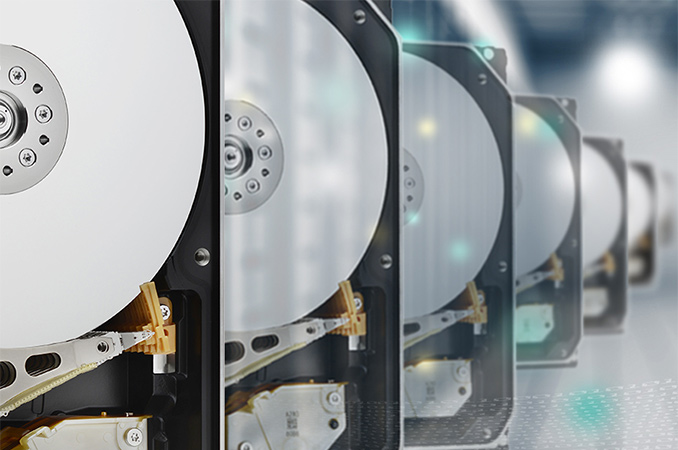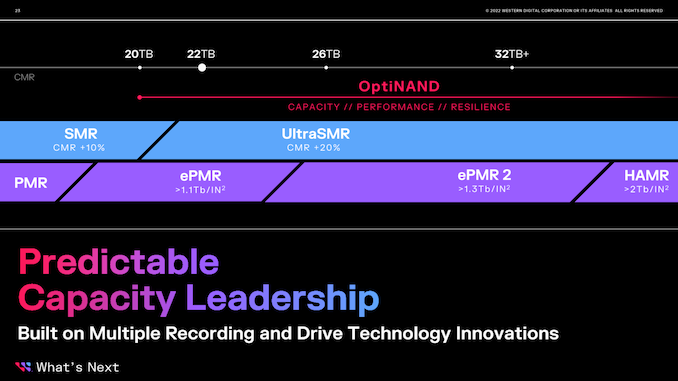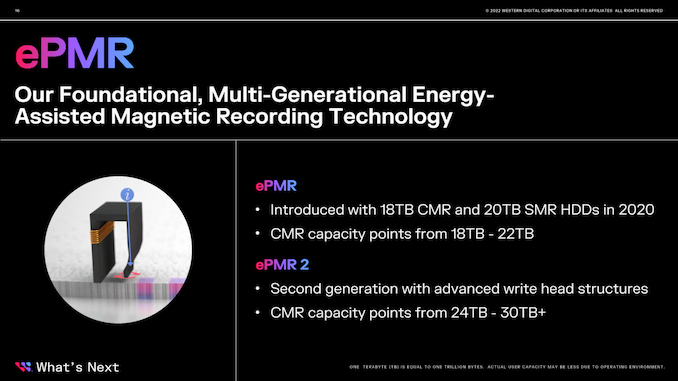Western Digital Estimates HAMR HDDs to Emerge in 1.5 Years
by Anton Shilov on June 12, 2023 8:30 AM EST
Western Digital is somewhat behind its rival Seagate in adopting heat-assisted magnetic recording (HAMR), which promises radical improvements to areal density and HDD capacities. Still, the company expects hard drives that use this recording method to enter mass production in the next 1.5 years. This technology will open doors for nearline drives offering 40 TB – 50 TB capacities in the coming years.
Seagate recently said it was months away from introducing its 32 TB nearline hard drives featuring its HAMR technology, with 36 TB and 40 TB HDDs to follow. The introduction of 32 TB hard drives will undoubtedly put Seagate in a leading position as far as capacity is concerned, as the highest capacity drive that Western Digital has today is its Ultrastar DC HC670 26 TB featuring UltraSMR set of technologies. At a recent conference, financial analysts asked Western Digital when the company expects its HAMR HDDs to emerge. The firm envisions these drives to enter mass production in circa 1.5 years.
"On the HAMR side, we are probably one year to 1.5 years plus before we get sort of volume production anyway," said Wissam Jabre, the chief financial officer of Western Digital, at the Bank of America Securities 2023 Global Technology Conference (via SeekingAlpha).
HAMR is a highly complex technology. It requires novel platters capable of enduring intense local heat of approximately 450°C or higher (generated using a laser with an ~810 nm wavelength and a ~20 mW power) without deforming over time. These platters are expected to be made from glass substrates and covered with a thin Fe-Pt alloy magnetic layer to ensure reliability and resist eventual deformation.
"HAMR could be one of the next on the roadmap," said Jabre. "[…] Our engineering teams have done a lot of R&D around [HAMR] […], it requires a lot of work on the material science as well as the physics. But also, much work is required in terms of commercialization, meaning being able to manufacture at scale, ensuring the yields are where they need to be, and having a reliable product that can last for several years. So, it takes time to get there."
All HDD makers have been working on HAMR HDDs for well over a decade, but only Seagate decided to bet on HAMR boldly. In contrast, Toshiba and Western Digital adopted energy-assisted perpendicular magnetic recording (ePMR) and microwave-assisted magnetic recording (MAMR) before adopting HAMR.
Western Digital's roadmap includes the 2nd Generation ePMR 2 platform, which allows for areal densities over 1.3 Tb/inch2 (an 18% over ePMR). Such areal density will enable the company to build 3.5-inch platters with a capacity of over 3.5 TB. Thus Western Digital will be able to offer HDDs with a ~36 TB capacity featuring 10 of such disks in the coming quarters. Meanwhile, the company says this technology will be used for CMR HDDs with 24 TB – 30+ TB capacity points.
Of course, the key question is when precisely such drives are set to be announced, qualified, and shipped. But at least it looks like Western Digital is set to stay competitive with Seagate regarding HDD capacities for the foreseeable future.
As for HAMR, Western Digital expects this recording technology to enable areal densities higher than 2 Tb/inch2, which allows it to build ~5.4 TB 3.5-inch platters, opening doors for HDDs with capacities of around 50+ TB.













16 Comments
View All Comments
sheh - Monday, June 12, 2023 - link
"one year to 1.5 years plus""1.5+" implies also 2 years possible.
"HAMR *could be* one of the next"
More uncertainty?
"reliable product that can last for several years"
"Several" and not "many". Questionable long-term reliability?
meacupla - Monday, June 12, 2023 - link
HAMR is not the only technology at increasing HDD density.A 7 year lifespan/warranty is excellent for a server grade HDD.
Most server grade HDDs don't last more than 10 years anyways, and usually only come with a 5yr warranty.
ballsystemlord - Monday, June 12, 2023 - link
I'd be more concerned about cost and performance with these advanced technologies.Kevin G - Monday, June 12, 2023 - link
The performance aspect isn't as critical nowadays as anything requiring performance has migrated to flash. Pricing will be expensive but less than enterprise flash, especially at a price/TB metric. Hard drives have their niche but it is shrinking.ballsystemlord - Tuesday, June 13, 2023 - link
And I do so love HDDs, but they're really getting to the point where a performance boost would be quite meaningful to a lot of users. It's not impossible either (2 independent heads have already been demonstrated), it's just a matter of advancing the tech.FunBunny2 - Monday, June 12, 2023 - link
Questionable long-term reliability?bidnezz couldn't care less. the Bean Counters weigh the numbers -
capacity
MTBF
warranty period
price
so - they'll take the drives that maximizes the one (or several, with the weights they care about) metric. and buy 10s of thousands. when the warranty is about to end, they'll buy another 10s of thousands. rinse. repeat.
as a general rule - getting to the end of warranty with minimum failures is the easiest to manage. will a few TBs make a difference? not likely, if the warranty or MTBF are even a smidge better.
PeachNCream - Monday, June 12, 2023 - link
Yeah spinning rust tech - great, whatever, you do you WD.Meanwhile, can someone please develop a solid state storage method that doesn't die after a couple thousand p/e cycles or fail at data retention if it's stored someplace warm for a year or two? We could kinda use that, perhaps somewhat more urgently than higher density hard drives.
EnFission - Monday, June 12, 2023 - link
The issues you mention are not present on HDDs, so maybe they're still relevant and could do with continued development. It is unlikely those issues will ever be solved as manufacturers constantly strive for ever higher cell density, which is more marketable but negatively affects write cycles. There's also the argument to be had that manufacturers are fine with endurance levels as they are since it is an acceptable amount of planned obsolescence.sheh - Tuesday, June 13, 2023 - link
On the other hand, the initial move to layers ("3D NAND") included also an increase in cell size to improve various properties.Maybe with more layers, and when reaching a capacity that's more than enough for most people, manufacturers could start to differentiate based on other properties, like write durability and data retention.
2TB is mainstream now, and 4TB not rare either. Hynix plans +50% layers in 1-2 years. Roadmaps from them and others expect a doubling or more a few years later.
nandnandnand - Tuesday, June 13, 2023 - link
I heard about this amazing technology called 3D XPoint, or Optane.In the meantime, have some PLC NAND.